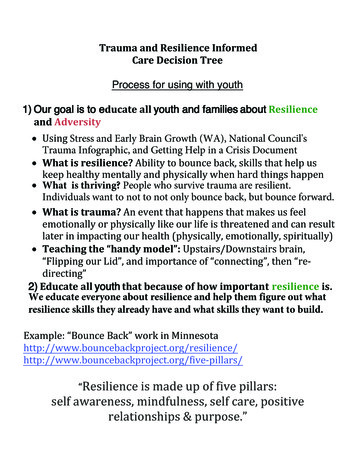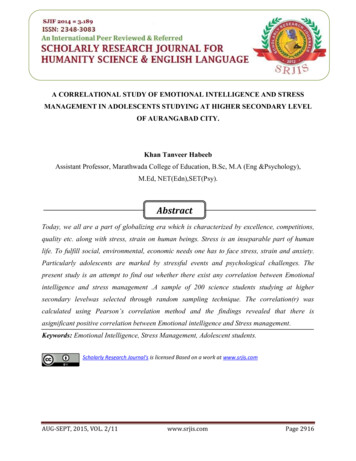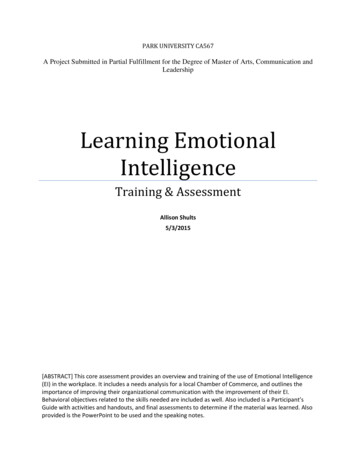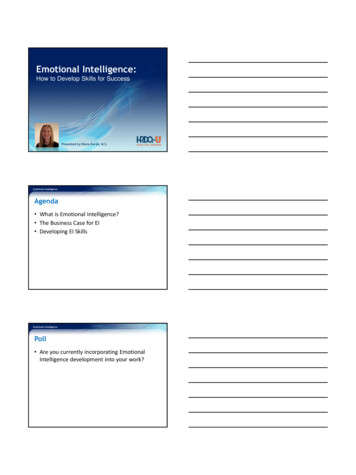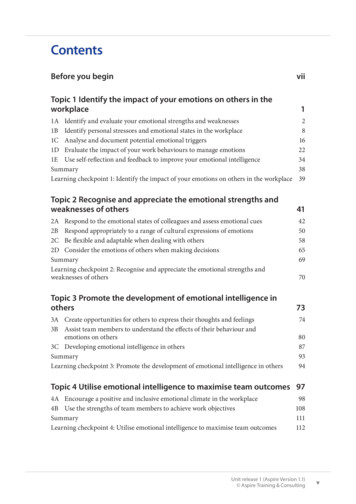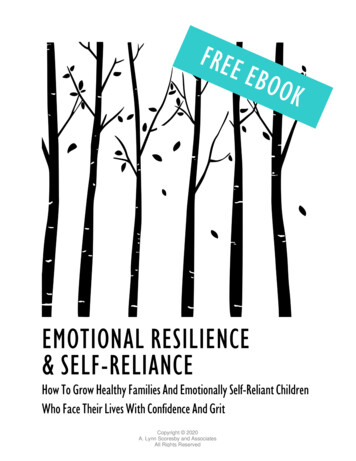
Transcription
EMOTIONAL RESILIENCE& SELF-RELIANCEHow To Grow Healthy Families And Emotionally Self-Reliant ChildrenWho Face Their Lives With Confidence And GritCopyright 2020A. Lynn Scoresby and AssociatesAll Rights Reserved1
EMOTIONAL RESILIENCE & SELF-RELIANCEMaking Yourself, Your Family, And Your Relationships Healthy And SuccessfulINTRODUCTIONEmotional self-reliance is the desirable outcome of growth and development that enables aperson to achieve, succeed with people, find satisfaction with life, and generally enjoy goodhealth and much happiness. It means being able to manage your emotions to limit the negativeand more fully enjoy the positive. Healthy emotional development includes feeling free toexperience healthy emotions without excessive distress and knowing that you have a choiceover what you feel or how intensely you feel it. It is usually a result of a combined and healthynature-nurture process. Under optimal conditions, it develops gradually over several ages andstages. Because there is a strong combination of learning and maturation involved, this form ofdevelopment is often highly vulnerable to risk conditions, which might exist both in terms ofwhat a person inherits and what a person finds and experiences (or fails to find or experience)in his or her environment.Virtually every individual’s environment includes people and other experiences with the naturalworld. Therefore, emotional self-reliance develops in the context of human relationships andother individual, non-relational experiences. For this reason, a two-part definition of emotionalself-reliance is necessary. One part is a description of individual traits and qualities as displayedin his or her mental and emotional response to conditions in the environment (e.g., response toadversity, honest, reaction to stress, emotionally intelligent, etc.). The second is the emotionalqualities displayed in relation to other people (e.g., confident, anxious, empathetic, etc.). Bothare necessary to define either the existence of mature emotional self-reliance or indications it isnot fully developed.Useful Facts About Emotions And How They Develop And GrowIn many cases, the role emotions play in our lives is confusing. Sometimes they add color to thepaintings of our lives. Sometimes they are troublesome. Quite often emotions influence uswhen we don’t want them and fail us when we do. Because they seem a bit confusing, most ofus create strategies to deal with them. These strategies include an interesting variety. Forexample, many try to manage anxiety by creating specific and rigid routines and following themeach day. Others get frantic when anxious and try to keep busy and work until the feelings goaway. For those who feel lost and despondent when depressed, they call and talk to people ordo something fun. Others think about dying just to rid themselves of the problem. Young loversstart out being thrilled when the first feelings of love blossom, but they might start feelingCopyright 2020A. Lynn Scoresby and AssociatesAll Rights Reserved2
afraid and begin to worry that the original feelings will be lost. When they don’t feel as theywould like, they develop recipes to keep the feelings or regain them.We are concerned about our children, and we wish to provide more help, guidance, education,and support for them. We understand that many of the problems that affect them have to dowith emotions. Either there is too much of the wrong kind or not enough of the right kind.Therefore, we are concerned about how emotions develop and grow because we have come tounderstand that emotional development will be essential for the successful lives we hope ourchildren will lead. In fact, research suggests that anxiety that’s too intense is manifest in thelives of too many of our children. Depression, which is the sad absence of any positiveemotions, affects a growing number of them, weakens them, and often prevents them fromliving the healthy lives all children deserve. Emotions are involved in addictions, where thenature of the addiction is often an effort to reduce stress by taking a chemical substance thatreduces the feelings of it. Or the new plague of pornography addiction is a biological responseseeking an emotional goal of some kind. In all of these, emotions are also necessary for thehealing and resolution of these problems. Usually it is to regulate negative emotions and createmany more positive emotions.So, let’s begin with some basic facts about emotions so that you can understand them and howto promote your children’s health and happiness. Begin with the idea that the term“development” means that something changes overtime, and these changes can progresstoward a positive end, or they can be delayed. The idea of development also means thatparents can have a very effective role in shaping or influencing how children turn out. Howemotions grow and develop includes: (1) learning more about them and how we are influencedby them, (2) how to be responsible for them and use them wisely, (3) how to express those thatare positive with more variety and utility, (4) how to understand those that are negative andregulate the experience of them and how they are expressed, (5) how to create a larger mentalcapacity for those that are positive so the experience of them is more intense, longer lasting,and can be applied effectively in our own lives and in our relationships with others. Thesedescriptions of development produce two general outcomes—emotional resilience andemotional self-reliance. Starting out with the following information about emotions will beuseful to your parenting.1. POSITIVE AND NEGATIVE EMOTIONS ARE INHERITEDSome positive and negative emotions appear to be inherited: joy, sadness, fear/anxiety,anger, anticipation, surprise, disgust, and trust.2. EMOTIONS HAVE PARTNERSEmotions are organized into pairs (sometimes combinations and sometimes pairedopposites), which means that the expression of one usually means the other is readilyavailable.Copyright 2020A. Lynn Scoresby and AssociatesAll Rights Reserved3
Examples:joy & sadnessfear & angeranticipation & surprisedisgust & trustlove & anxietyThis means that children will have both positive and negative emotions, and it will beuseful for you to learn how to recognize, understand, communicate about, and guideboth. Plus, knowing that emotions typically come in pairs will help you understand howchildren’s emotions sometimes change quickly. Knowing this will help you better explainwhat is happening to them and how to guide them.3. EMOTIONS HAVE THREE BASIC ELEMENTSEmotions have more than three elements, but knowing three will be a good start.Where emotions are concerned, children learn “what” they experience rather than, orin addition to, what they learn “from” their experiences. If a child feels a lot of anger, forexample, he will retain anger because he is learning anger as an emotional response. If achild feels a great deal of love, he will also learn that. These three basic elements aboutemotions will help explain how they develop.EMOTIONAL STATEThis is the body’s reaction and response (pulse rate, breathing, etc.) to emotions. Peoplecan create cycles of body response and emotional experiences to perpetuate depression,anxiety, and other positive emotions. Changing physical response changes feeling.Retaining good health habits coincide with a healthy emotional life.EMOTIONAL EXPERIENCEThis is one’s interpretations of his or her positive and negative feelings. (Examples: “I feelhappy,” “I am so sad,” “I love you.”) How individuals understand their own emotions isrelated to their identities and self-concepts. If they feel positive feelings most of the time,they will likely think they are a happy, confident person. Positive self-esteem andconfidence are related to feeling more positive than negative emotions.EMOTIONAL DISPLAYSDisplays are the way emotions are expressed or displayed in a person’s facial expressions,gestures, and movements. Some displays are universal, and everyone displays them thesame way (smiling when happy), some are cultural (expressing negative emotions in publicvs only in private), and some depend on the individual or family. Displays are the parts ofemotions that are to be encouraged and regulated in order to develop self-reliance. Forexample, the more displays people have of positive emotions, the happier they are andgenerally find more success, individual fulfillment, and satisfaction in their relationshipswith others. The better people can understand and regulate negative emotions, the morelikely they are to avoid problems and live successfully.Copyright 2020A. Lynn Scoresby and AssociatesAll Rights Reserved4
4. THE PURPOSE OF EMOTIONSEmotions focus our attention, motivate us, and provide meaning about ourselves, thenatural environment, other people, and our relationships. Understanding how to useyour own emotions and how to help children use theirs will enable you to motivate, tohelp them focus, and to understand their experiences with people and with the worldaround them. The more self-knowledge children have, the more likely they are to makegood decisions.5. HOW EMOTIONS ARE CAUSEDEmotional states, experience, and displays are usually caused by our interpretations orthoughts, choices, and actions even though it may seem like they are caused by eventsor people external to us. Self-reliant people tend to recognize they are responsible forwhat they feel and how their feelings are expressed. This does not mean they judgethemselves as being wrong or guilty for their emotions, but instead they avoid blamingothers, accept their feelings, and learn to channel them toward a healthy place.6. WHAT EMOTIONS BECOMEEmotions and their expression become our personality traits and character qualities. Bylearning how to promote emotional self-reliance, you are actually influencing thepersonality and character of your children. This can be accomplished by helping childrenunderstand and communicate about their emotions, by learning a sense ofresponsibility for how they display them, by creating positive emotions, and by learninghow to regulate the way negative emotions are expressed. This is made possible by thefact that large numbers of emotions and their expressions are learned.It’s important to note that many highly valued emotions will be present in someone’s lifeonly if they are learned (e.g., loving and being loved, happiness, hope, optimism, confidence,peace, security, empathy, compassion, gratitude, tolerance and acceptance of others, etc.).What Emotional Self-Reliance Looks LikeEvery culture will have its own definition of what emotional self-reliance looks like. As parents,you might have your own definition. If we had research about the qualities that lead to humansuccess and we add our own observations of what effective people are like, we can get a prettygood idea about what emotional self-reliance looks like. The following qualities are matureforms of behavior that characterize the positive forms of development. There are likely othersnot included here, but these will serve as examples to help you clarify what the objectives orpurposes for your work as parents might be.Copyright 2020A. Lynn Scoresby and AssociatesAll Rights Reserved5
KNOWING HOW TO LIVE SUCCESSFULLYMost of us are faced with life decisions that are usually part of a basic map or methodof how to live successfully. These decisions also include how to create and followsuccess strategies, which guide how to prepare for competence at work, how tosucceed financially, how to create social success, how to form positive relationshipswith others, how to weather adverse conditions, how to solve family problems, howto decide about and live consistent with moral values, how to be a good neighbor, andhow to be a positive and contributing member of society.EXPERIENCING MORE POSITIVE THAN NEGATIVE EMOTIONSThere are positive emotions, such as love, cheerfulness, peace, and happiness. Thereare negative emotions, such as anxiety, anger, revenge, resentment, etc. Emotionalself-reliance exists when people feel or experience more positive emotions thannegative and learn how to produce positive emotions for themselves and graduallyimprove their abilities to clearly and accurately express them toward other people.DEVELOPING A SENSE OF SELF-CONTROL ABOUT EMOTIONS AND THOUGHTSWhen responding to some environmental pressure or reacting to another person’sactions, emotional self-reliance exists when there is at least one degree ofautonomy—a sense of free choice—before an individual reacts or responds tosomeone else's behavior or the perception of it. For example, when confronted withdisappointment, stress, or frustration, people with emotional self-reliance willrecognize that they can choose how to think, feel, and respond positively to thesituation instead of feeling reactive and totally controlled by the situation or anotherperson.GENERATING POSITIVE FEELINGS AND REGULATING NEGATIVE EMOTIONS DURINGDISTRESSEmotional self-reliance is demonstrated by the ability to rise above and persist duringperiods of emotional distress by regulating negative emotions and creating optimism,identifying learning options, and creating a hopeful, long-term view of anycircumstance (instead of feeling helplessly trapped in a current situation).DISPLAYING SOCIAL CONFIDENCE AND ADAPTABILITYEmotional self-reliance is demonstrated as social confidence, which means beingcomfortable with several different types of social situations. It is also demonstrated byinterpersonal competence, which promotes success in relationships with otherpeople. It also is evidenced by the ability to learn and successfully adapt emotionaldisplays and language for several different social circumstances.Copyright 2020A. Lynn Scoresby and AssociatesAll Rights Reserved6
BEING RESILIENTEmotional self-reliance is demonstrated by resilience (bouncing back) in the face offailure, loss, or tragedy.STARTING, PERSISTING IN, AND COMPLETING WORKEmotional self-reliance exists when individuals demonstrate the ability to start work,persist in working, and complete the tasks that are part of work.DISPLAYING FORGIVENESS, TOLERANCE, INTEGRITY, COMPASSION, AND EMPATHYThe outcomes of successful development are expressed in several high-order socialforms of behavior. This includes moral behavior, such as honesty and integrity.Successful development is also demonstrated when people can display forgiveness,sacrifice, service, love, tolerance without prejudice, acceptance of others, empathy,and compassion.HAVING MANY FRIENDS AND ACQUAINTANCES AND BELONGINGEmotionally mature individuals usually create and maintain several different types ofacquaintances and friendships. Although they may at times prefer to be alone, theyusually enjoy and find value in meeting people, conversing with people, and learningfrom people. This sense of belonging provides some security and safety and also tendsto lead to the ability to form and maintain emotionally intimate relationships.FEELING AND EXPRESSING GRATITUDE FREQUENTLYSelf-reliant people appreciate the contributions of others and the kindnesses andblessings they have received. When they have these feelings and express them, itproduces brain neurotransmitters (dopamine) that lifts spirits and creates morehappiness and satisfaction.MAKING AND KEEPING PROMISESSelf-reliant people have a strong sense of honor when it comes to making promisesand keeping them. They are typically less impulsive about decisions, even though theycan be spontaneous, but after making a promise will organize their lives in order tokeep or honor them.DELAYING GRATIFICATIONEmotionally self-reliant individuals do not give up what they want most for what theywant at the moment. They can delay gratification to achieve goals. They can limitimpulsiveness in order to achieve something that would be better for them and forother people than if they would have impulsively chosen.Copyright 2020A. Lynn Scoresby and AssociatesAll Rights Reserved7
FAMILIES CAN CREATE AND MAINTAIN HEALTHY EMOTIONALAND COMMUNICATIONAL CONNECTIONS12LEARN MORE ABOUT EMOTIONAL INTELLIGENCE (BEING AWARE OF AND ADDINGEMOTIONAL KNOWLEDGE TO YOUR RELATIONSHIPS). Learn about emotions and the role of emotions in family life. When family memberssense and understand their own emotions and others’ feelings, they tend to be better atcommunication, which results in more successful relationships. Accurately gauge your children’s displays of emotions, and use them wisely when youcommunicate with them. Add emotional support when communicating expectations for children’s performance. Comfort rather than ignore when children are distressed. When making decisions about children, search for and understand children’s feelings aspart of formulating any plan and decision making. Emphasize being able to adapt feelings and their displays, and make adapting part ofwhat you teach your children. Individuals who are better at adapting successfully toseveral different types of social situations typically are more confident and successful intheir relationships.BE AN EMOTION COACH TO HELP CHILDREN LEARN TO UNDERSTAND AND REGULATE THEIREMOTIONS.Become aware of a child’s emotions, recognize the emotion as a time to teach and be close,listen empathetically and validate, help the child find labels that match his or her emotions, andset limits while creating a strategy to solve the problem.3TEACH YOUR FAMILY STORY, AND HELP YOUR CHILDREN BE RESILIENT.Ensure that all family members know about and feel a part of your family story. This is a familylearning experience that is most likely to ensure the emotional wellbeing of children. It is aboutsignificant events in your family history or modern day. It is about the people in your family andtheir contributions, and it is about the qualities the story suggests for the people who arecurrently living in the family.Copyright 2020A. Lynn Scoresby and AssociatesAll Rights Reserved8
4TEACH AND COMMUNICATE OFTEN ABOUT POSITIVE AND NEGATIVE EMOTIONS.Be examples of and teach about positive emotions. Help children know and understandnegative emotions and learn to regulate them. Carry out conversations about feelings toexplain when and how to display certain emotions and when not to display them. Refer to theemotional experience of family members (e.g., ask about feelings gently until everyone feelssafe to talk about them) during communication from time to time in order to promoteunderstanding. This will ensure that family members will consider each other’s feelings insteadof lacking sensitivity and awareness. It will also help children know when and how to displaytheir feelings.5TEACH THE EMOTIONAL STANDARDS OF FAMILY MEMBERSHIP.Identify a few emotional standards for your family, and ask everyone (do not demand it) todemonstrate that membership by honest communication, love, loyalty, cooperation, andkindness.6EXPRESS ANGER SPARINGLY AND MILDLY.Control the expression of anger because it frightens and separates people. Learn to use calmconversation and effective communication instead.7CREATE SHARED PROJECTS—AND MENTOR.Working together on family projects can teach cooperation and create feelings of unity andbelonging. Parents can create a warm mentoring relationship with the child.8EAT FAMILY MEALS TOGETHER.Research clearly shows that when family members eat together often and regularly, childrentend to do better in school, are less likely to become involved in substance abuse, less likely tosuffer the effects of depression, and find their friendships and relationships more successfuland satisfying.9EXPRESS HEALTHY LOVE AS A NATURAL AND REGULAR PART OF FAMILY LIFE.Love expressed in many forms is a natural and healthy family connection. When it is withdrawnto punish, used to exploit or manipulate, used to accuse, demanded to impose guilt, or is whollyabsent through abuse or rejection, the expectation of loving and being loved becomes an acheof loneliness and insecurity, a source of inferiority, and a lifetime lack of fulfillment.Copyright 2020A. Lynn Scoresby and AssociatesAll Rights Reserved9
FAMILIES CAN CARRY OUT CONSTRUCTIVE ACTION PLANS1. KNOW HOW EMOTIONAL SELF-RELIANCE DEVELOPS, AND TEACH ITS PRINCIPLES.Parents can become acquainted with emotional self-reliance and be knowledgeable aboutwhat it is like when it is mature, how to promote it, what the symptoms are of its absence,and what may prevent it.2. ORGANIZE A FAMILY PLAN TO PROMOTE EMOTIONAL SELF-RELIANCE, AND PROVIDE LEADERSHIP TOSTRENGTHEN CHILDREN AND AVOID POTENTIAL PROBLEMS .This can include a regular parent leadership or organization meeting to communicate plansfor the family, set goals for each child, sustain the plan, and promote the goals. Involvechildren in the development of these plans and goals as they are ready, and ask them to settheir own goals.3. DIFFERENTIATE YOUR CHILDREN AS UNIQUE INDIVIDUALS , AND ORGANIZE A PLAN SUITED FOR EACH .Identify children who have inherited a high level of brain reactivity, and identify those who didnot. To be successful with each child, you may need to adapt what you do in your familycommunication, discipline, and work.4. UNDERSTAND FAMILY AND CHILD DEVELOPMENT , AND PREPARE CHILDREN FOR FUTURE SUCCESS.Organize your family with a developmental approach. Have a plan to promote growth(learning) adapted for each child, and then do your best to provide an emotional environmentthat includes (1) some stability and positive predictability for children and (2) mentoring timebetween parents and children.5. CREATE A CLIMATE OF SAFETY, AND MAKE SURE CHILDREN FEEL LOVED .Create a family environment where children feel safe by a calm approach and a predictableand just form of discipline, helping each child learn to be contributing and productive familymembers and ensuring that each family member feels loved because parents express it andshow it.6. APPLY POSITIVE DISCIPLINE, AND DIMINISH ANGER AND FRUSTRATION.Promote a positive approach to managing children so that you feel enough influence andavoid overreacting to what children do or say. You can do this by doing the following: Prepare more than you punish. Individualize and involve. Encourage more than you criticize. Resolve together more than you isolate. Communicate more than you control. Love enough to limit.Copyright 2020A. Lynn Scoresby and AssociatesAll Rights Reserved10
7. ADAPT YOUR DISCIPLINE APPROACH AS CHILDREN DEVELOP.As your children mature, adapt your family discipline approach from being rules- andconsequences- centered, and add increased emphasis on your relationship with children.When children are judged to be sufficiently mature, trade a rule or two for a high-qualityrelationship. (1) Focus on building and maintaining trust by both you and the children sayingwhat you will do and doing what you say, and (2) create high-quality communication bykeeping each other informed and by displaying warmth, affection, and love to each other.8. GRADUALLY CREATE INDEPENDENT DECISION MAKING.Take your children through a developmental process of decision making. Make early decisionsfor them, and then move to where you make decisions with them. This can be followed byasking them to make decisions themselves and present them to you so you can help themexamine the wisdom behind them. Lastly, encourage them to make their own decisions.9. UNDERSTAND PERSONAL FABLES AND IMAGINARY AUDIENCES.Personal fables are stories youth create about themselves that are often not based on realitybut can be exaggerated either positively or negatively. Imaginary audiences are the “people”youth believe they are performing for, such as their friends, family, teachers, etc. Help yourchildren have sufficiently broad and accepting fables and audiences so they don’t imagine theneed to be too perfect or see themselves as inferior.10. TEACH MORAL BEHAVIOR AND MORAL LEADERSHIP B Y USING INDUCTIVE COMMUNICATION .Teach that moral behavior helps someone, and what is not moral will hurt or harm someone.Instead of dealing with children’s bad behavior by ignoring it or thinking that imposing someconsequence will be enough, make corrections that include using inductive communication.This form of communication refers a child to his or her feelings and to the feelings of others.When linked to the idea of what helps or harms people, all moral qualities, such as integrityand honesty, are based on this idea. Children can learn to organize their lives so they willstand up for what is right and resist the pressure to do something that will harm themselvesor others and resist the pressure to not do something when action is needed.11. TEACH HEALTHY BELONGING, INCLUSION, AND OTHER SOCIAL SKILLS.Help your children learn to include others, meet and greet people, give compliments, askquestions and listen, adapt their emotional behavior appropriately from one situation toanother, and assert their opinions in social situations.12. CREATE A TRADITION OF DOING HARD THINGS , AND COMBINE WITH EMOTIONAL SUPPORT.Build a tradition and create a theme or value that surrounds your children with the idea thatas a family you face and do hard things. Also provide emotional support. This reduces fear ofchallenges and builds confidence about the ability to survive and succeed when facing thingsthat look hard to do.Copyright 2020A. Lynn Scoresby and AssociatesAll Rights Reserved11
To find out more, see our courses on FirstAnswers.com!Sign up for a 12-week group videoconference course on Emotional Resilience& Self-Reliance, guided by a professionalcoach—with a free course eBook included!CREATE YOUR OWN GROUPYou can even create your own group forthe video conference course. Registerwith friends, family, your church group,or community group. Strengthen yourrelationships while you’re learning!In the Emotional Resilience & Self-Reliance course, learn how to limit depression and anxiety. regulate technology use. guide your children through difficult emotions. use positive discipline to reduce anger. build social confidence. teach your children to start, persist, and finish work.INCLUDES COMPREHENSIVE 140-PAGE eBOOKPurchase of the course comes with a 140-pageeBook—complete with readings, learning activities,and family action plans so you can learn and thencarry out what the most successful parents do toraise healthy families and emotionally self-reliantchildren who face their lives with confidence and grit.12
GAIN CONFIDENCE AND BETTER PARENTING TOOLSSO YOUR CHILDREN AVOID DEPRESSION ANDANXIETY, LEARN TO DO HARD THINGS, ANDSUCCEED IN THEIR RELATIONSHIPS AS YOU LEARN how to usepositive disciplineto reduce angerhow emotionalself-reliance cancombat anxietyand depressionhow to teach yourkids resilience andsocial confidenceaction plans toraise anemotionallyhealthy familyBETTER TOOLS FOR 21st-CENTURY PARENTS13
For this reason, a two-part definition of emotional self-reliance is necessary. One part is a description of individual traits and qualities as displayed in his or her mental and emotional response to conditions in the environment (e.g., response to adversity, honest, reaction to stress, emotionally intelligent, etc.). The second is the emotional

